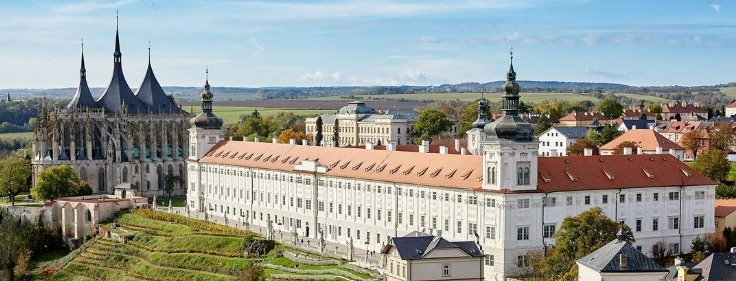Every guide book to the Czech Republic opens with pages of detail about Prague.
The beautiful 500 year old and still authentically medieval capital city is undoubtedly the country’s biggest draw, and its mainstay of economic success. It’s become increasingly expensive to visit but is still packed all year round with international tour groups and exuberant stag and hen parties.
Having navigated through them five years ago on our first visit to Prague we decided this time to give it a miss and instead spent a few days exploring the rural countryside and renaissance towns south of the city in Bohemia.

Kutná Hora was a silver mining town in the 1300s and its influential mint provided the coins used as currency across Central Europe. Consequently the town became a sophisticated and fascinating architectural centre which only stopped developing when the mines of silver ore ran dry in the 1700s.
We spent a day enjoying all of the highlights of this UNESCO World Heritage listed and very much lived-in and bustling town.
In the high heat of late morning, office workers and shoppers stopped at the striking stone and late Gothic drinking fountain which was created as part of the town’s early water distribution system around 1495 by the Master Bricci.
Water bottles were filled from the same public and free source that townsfolk have used for more than 500 years.
St Barbara Cathedral is equivalent in size to Prague’s St Vitus but is a unique work of architecture.
Construction was begun in 1388 but halted several times, often due to war and lack of local funding, and finally completed in neo-Gothic style in 1905. Anchored by lines of impressive flying buttresses it seems to soar skywards. The chapels inside contain original 15th century frescoes showing the silver miners at work.

Along the terraces of the impressive Jesuit College high above the town we had wonderful views across the vineyards down to the winding centre of medieval traders’ houses, religious buildings and shops.
Gazing past the statues of saints along the walls of the college, the view was impressively grand although the town itself is on a small and manageable scale.

Meandering through its cobbled streets past the fortified houses and palaces of the wealthy burghers (and brigands) we found the peaceful courtyard of the Italian Court, so named after the Italian experts at the forefront of minting reform in medieval Europe.
The warm ochre walls of the Italian Court were topped with onion domes and copper dove houses, and as well as being the town’s mint and home to the official minter of the coins, it was also the temporary residence of the Bohemian Kings. Nearby houses boasted colourful facades of frescoes relating their history as places of trade and pleasures.
We found the railway station after following several locals ambling alongside the dusty rail tracks, which seemed to be the way to get onto the single platform.
EU funding had given the crumbling brick station a recent face-lift but the money had stopped short of providing sidings and security it seemed. A short ride of less than two minutes took us into the unassuming suburb of Kostnice to see the extraordinary Sedlec Ossuary.
Originally part of Bohemia’s oldest Cistercian Monastery, dated 1152, the cemetery church was built in the Gothic style in late 1300s by which time thousands of Catholics wished for their burial in its grounds as it was said that some soil from Golgotha had been sprinkled there.
Following a series of devastating plagues in the town, and the Hussite war, some 40,000 people in total are thought to have been interred in the cemetery grounds and church.
By the 1600s the practice of cleaning and arranging the bones of the dead in decorative fashions was being recorded by passing travellers. Today the church is both an Ossuary and a bizarre work of bone art.
Honestly, it is hard to know what to feel and think about it. Neither of us enjoyed our visit but both were struck with the odd balance of the message of hope in the afterlife, and the gruesome and vivid display of mortality. Particularly peculiar were the modern plastic cherubs propped on shin bones and poked inside skulls.
It was frankly a relief to get outside and walk the hot and dusty rail road back to the charming town which we both agreed was an unexpected delight and a real trip find.

















